As an Amazon Associate I earn from qualifying purchases.
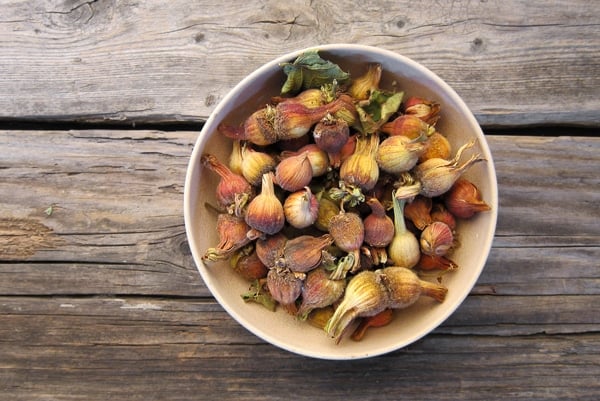
One of the more amusing things about foraging is that you can covet a certain plant for years and years, but never find it. Then, when you finally do, you start to see it everywhere. This was the year I cracked the code on how to harvest hazelnuts, Corylus cornuta, in the wild. What makes harvesting wild hazels so hard? Glad you asked. I’ll tell you.
First, you don’t harvest hazelnuts in traditional nut season (read: autumn). Nope, hazelnuts come ripe in high summer here in California, or late summer in most other places. If you wait until late September, when most other nuts are ripening, you’re too late. I pick most of my hazels at the end of July and in early August.
Which brings me to the second problem. Finding hazel trees. Lesson One: Hazelnuts don’t grow on trees. They grow on shrubs. Rarely will a hazel grow past 15 feet high, and eight feet or less is pretty much the rule here. So you don’t want to look up to spot hazels.
(Keep in mind I am writing here solely about the beaked hazelnut, not the American hazelnut, which does not grow in California.)
In fact, you need to look down, or rather under. Hazels hide their nuts underneath their leaves, so harvesting them is a matter of moving around the branches and spotting the funny-looking beaky sheaths that enclose them.
But I’m getting ahead of myself. First you need to know where you might find beaked hazelnuts. In California, you will find hazelnuts only in Northern and Central California, on the coast, the Sierra Nevada or in the Sisykous. Beaked hazelnuts also can be found in western Washington and Oregon, in much of Canada, Minnesota, Wisconsin, northern Michigan, New York, all of New England and pretty much the entire Appalachian Mountain Range.
Now you need to identify the plant.
We’ve established that it’s a shrub. Hazels like to live kinda-sorta near moisture, but not right on riverbanks. I tend to see them near little streams and on roadsides. They also grow close to the shoreline on the Pacific Coast. They don’t look like much. They have a pretty typical leaf pattern, but look for the toothed edges and the fact that hazel leaves are fuzzy. The leaves also alternate like you see in the picture.
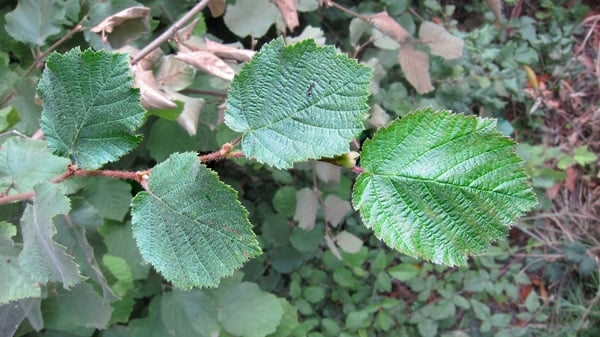
You may also see the male flowers, called catkins, on the plant as well. Incidentally, grouse and quail love to eat these.
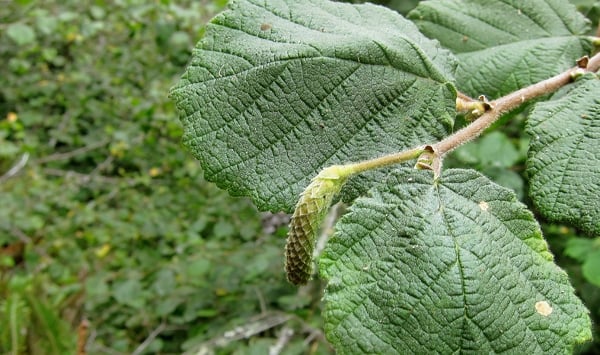
Start scoping out for unripe nuts around Independence Day. Start checking them toward the end of July and into August. You are looking for the nut sheath, called an involucre, to be mostly still green but with patches of color, ranging from rosy red to brown. Nothing else looks like a hazelnut, so there are no poisonous lookalikes to worry about.
Typically beaked hazels set single nuts, but doubles are pretty common. I’ve found quite a few triples and a few quadruples. My friend Sam Thayer says he’s found up to nine nuts in one cluster! Pick the clusters by twisting them off. Don’t break the twigs.

Now I ought to tell you that the involucres of beaked hazelnuts are covered in little fuzzy spines. They are not as bad as the hated glochids of prickly pears, but if you have soft hands you may want to wear gloves. I don’t, and yes, my hands bother me for a few minutes after I am done picking, but it goes away quickly.
Once you get home with your hazelnuts, you need to let the involucres dry out. I put the nuts in a big hotel pan in my garage to dry. They key here is to spread the nuts out in a thin layer — I’d say no more than two nuts deep. If you stack them too deep the ones on the bottom won’t dry as well, and if you live in a place where it isn’t arid, as it is here in NorCal, they could rot on you.
I left mine to dry for a couple weeks. This gives any nuts I might have picked too early a chance to ripen. Picking some nuts that are unripe is an occupational hazard, but if you wait until at least the end of July to pick (in California) you should be OK. You’ll know if the nut was unripe when it comes time to husk them: The husk sticks to the top of the nut.
Does this mean you need to toss the nut? Nope. But eat those hazelnuts first, as they will not store as long.
To husk the nuts, I just tear off the involucre with my hands. The hazelnut should roll right out. Yes, you will get the little pines all over your hands. Deal. Or wear gloves. There is no other good way to husk them in a dry climate. Sam, however, lives in Wisconsin. His technique will work if you live in a wet place: He buries his hazelnuts in mud for a month. When he digs them up again, the involucres are all black and rotted, but the nuts are just fine.
Keep in mind that wild hazelnuts aren’t as large as the domesticated filberts you buy in the store.
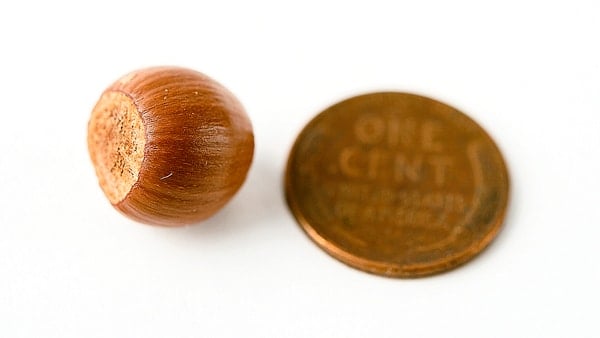
Once they’ve been husked, hazelnuts last for a long, long time in the shell. I’ve eaten 18-month-old nuts that tasted fine. When you are ready to eat them, just crack and eat. Or if you want to roast them, crack and lay the nuts in a single layer on a baking sheet and bake at 275°F. for 15 to 20 minutes. Don’t let them scorch, so watch them after 10 minutes or so. If you want to remove their skins, wrap warm hazelnuts in a kitchen towel and let them sit for 10 minutes. Rub off the skins in the towel.
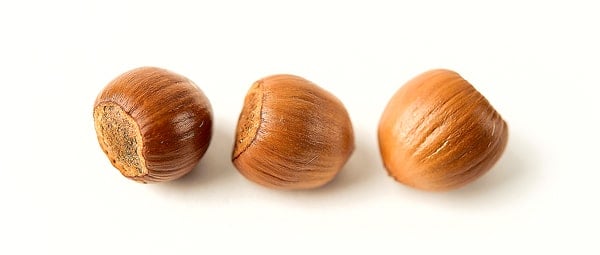





Here in Robin Hood county Nottinghamshire UK I have a couple of Kentish cobnut coppices (also known as filberts) which have yielded nicely today because the grey Canadian squirrel hasn’t got to them (I think that I shot it last year!). The grey is an alien but has largely wiped out the native red population over the last 100 years. The nuts are just turning and a sample has a well filled cavity with a fresh tasty nut and no weevil escape holes.
My query is that I am coppicing the hazel(i.e. cutting to about six inches off the ground), as is traditional in England for rods, walking sticks and hurdling material every seven years. If I lay off coppicing can I prune the tree into a better nut bearing shape rather than waiting about three years for it to produce nuts again?.
I live in Northern Northern Michigan on Sugar Island. My Mom taught me how to identify the nut bushes and how to handle them (carefully). This year there are more hazelnuts than I can ever remember. Usually the critters get them all, but tomorrow I am headed down the road with a basket and expect to fill it. I found the bushes all along the road we live on and they are loaded this year. My wife…always the skeptic…will love them.
I’ve tried to grow three CA into a hedge, but two have died in one of the spots and the other two, after five years, have never grown more than 1.5 ft tall and have never bloomed. Perhaps they’re too far under the hackberry tree canopy and aren’t getting enough sun and/or water? (I’m in garden zone 4, so my hazelnut options are limited. They grow in a park along the river about 5 miles south of me, but the squirrels get them.)
Thank you for this informative article on wild hazelnuts. I live in Northern Michigan (U.P.) and found them in my back yard. I remember as a kids seeing these in the woods and had forgotten about them until I was walking the perimeter of my yard, low & behold, there were bushes. I am so excited and can’t wait to pick a lot of them. I’ve picked a few, based on your information that I thought were ready and am drying them out. Thanks again!
Northern WISC. Is covered in hazelnuts! Bears love them too!
The hazel in my backyard here in Portland is ginormous! Must be overgrown or something – easily 20 feet tall with a huge trunk.
When I originally read this post, it was with great jealousy. For some reason I had it in my head that we didn’t have any wild nut trees in Newfoundland, but I was wrong. Days after your post, I literally tripped over a beaked hazel casing in the middle of a trail… likely dropped by a blue jay (the jays were going insane in the nearby shrubs). It took a bit of looking but my partner and I managed to find some and picked about a pound of them. Went back a few days later, found several more shrubs but no hazelnuts except a few on the ground. The local beasts are obviously doing a good job cleaning them up; I think we were very lucky to have found them at all.
I don’t know if we have beaked hazelnuts here, but I live in an older neighbourhood with lots of nut trees about. Right now is proving to be the perfect time to gather the falling nuts off the ground to take home and dry – glad I made this new discovery, and funny you should be talking about the same thing!
Wow! I just checked the CalFlora website to see where Corylus cornuta grows cause I am not familiar with it. It freakin grows everywhere. 0 to 7,000 feet. Every forest type and some grassland and even wet lands. Even though I am too late for this year’s harvest….I have a new mission. Gonna find me some hazelnuts and be prepared for the next harvest.
Thanks for a very informative article Hank.
Here in Northern Virginia, there are native species of hazelnut and a couple of years ago, the local water conservation board offered them in their annual tree and shrub sale. So, I have four little ones (they are still only about 18″ tall) that I am waiting on to grow and produce. Maybe I need to move them to an area that has more moisture.
Thanks Hank,
Found these to our great excitement on Labour Day….had recently seen your post but never thought we would find them in Newfoundland.
Fefe aka Susie
I recently picked at least 20 pounds of the Eastern strain of beaked Hazelnuts. I usually never find many, as the squirrels and other critters get most of them. But this year I nailed it !!. I am planning to make some Hazelnut & Coriander pesto with some and Hazelnut Ice -Cream with some and maybe sell the rest. The nuts are as large and plentiful,as i have ever seen this year. RP
The pictured nuts are just like those I picked from bushes in Ireland when I was a boy. They grew on bushes on slightly wet, ungrazed fields. All of the local children knew where they were but they were not picked until they had ripened about this time of year. We did not know that we were foraging!
Lesson for the day: Hazelnuts don’t grow on trees? All hazelnuts? Who knew! (Not me obviously…)
Clay: I don’t think they make it to SoCal. Sorry!
In California, how far south do wild hazelnuts grow? I live along the coast in Ventura (just south of Santa Barbara).
The wildlife here in MS never seem to leave more than a handful of Corylus americana.
Great article! I’ve been looking for the wrong thing.
The one place I have seen wild hazelnuts (or were they filberts?) was in England (near Lakenheath in East Anglia). A vendor had a small basket of them among other locally grown & foraged foods. She showed me the plant, bushy & similar to what you described, but the nuts were cased in a spiny casing that reminded me somewhat of a horse chestnut fruit. It split open into 3 pieces, and this is when they were harvested. The nuts were rather unusual, very elongated.
Ah, Wild Hazelnuts! A long-time favorite. When we built our house a dozen years ago, I got a few American hazelnut seedlings from my friend Ken Asmus at Oikos Tree Crops and those couple of plants have grown into a dense hedge along the south side of the house. We get as many nuts as we need, with plenty left over for the critters (although if you were to ask them, the squirrels and birds would certainly wish for more). Easy to grow, a lot easier to shell than black walnuts, and so many yummy ways to eat…you can’t beat hazel nuts!
The few hazel nuts that I have found in CA on bushes have near always been empty. Have I been looking for them too late? The few that had a kernel were nice though. (Same for Utah etc. pine nuts around Thanksgiving time.)